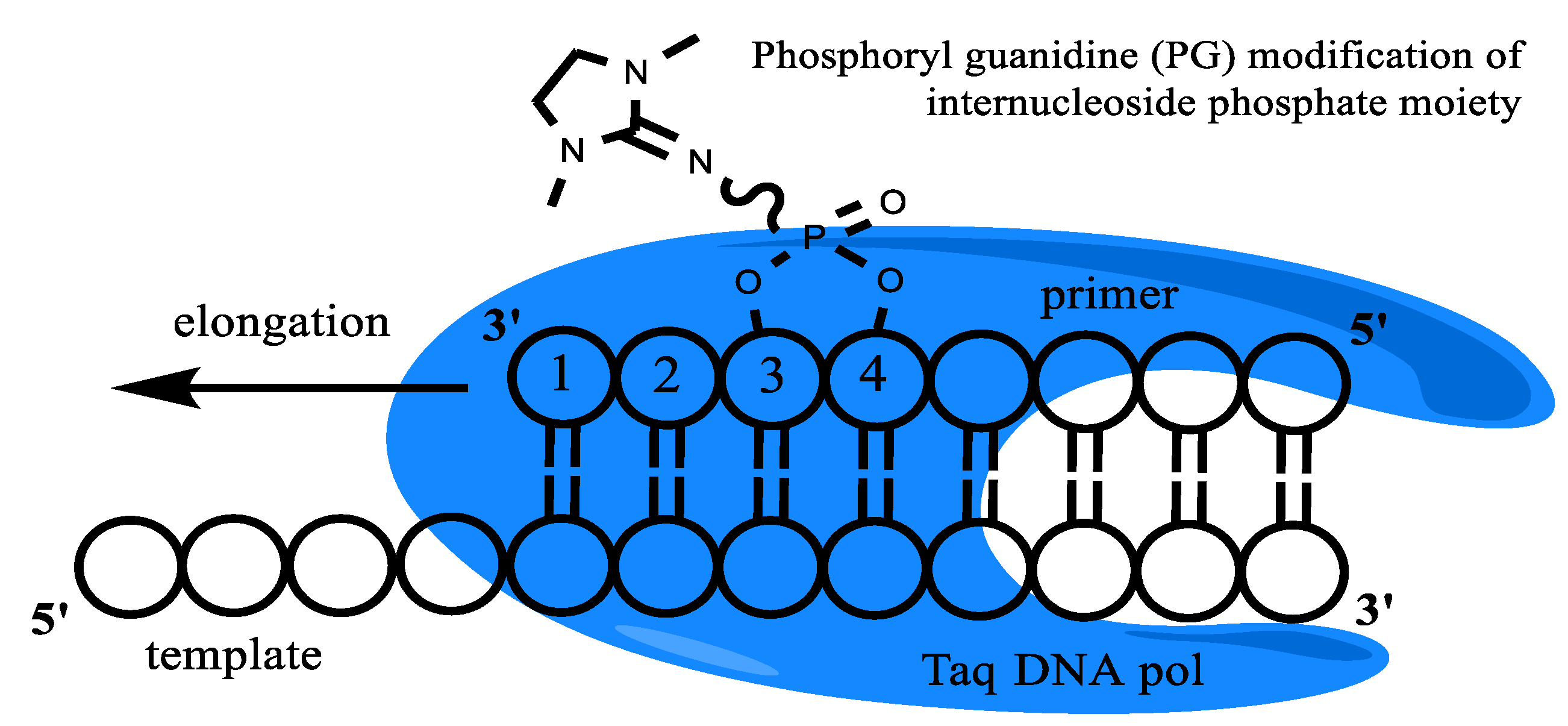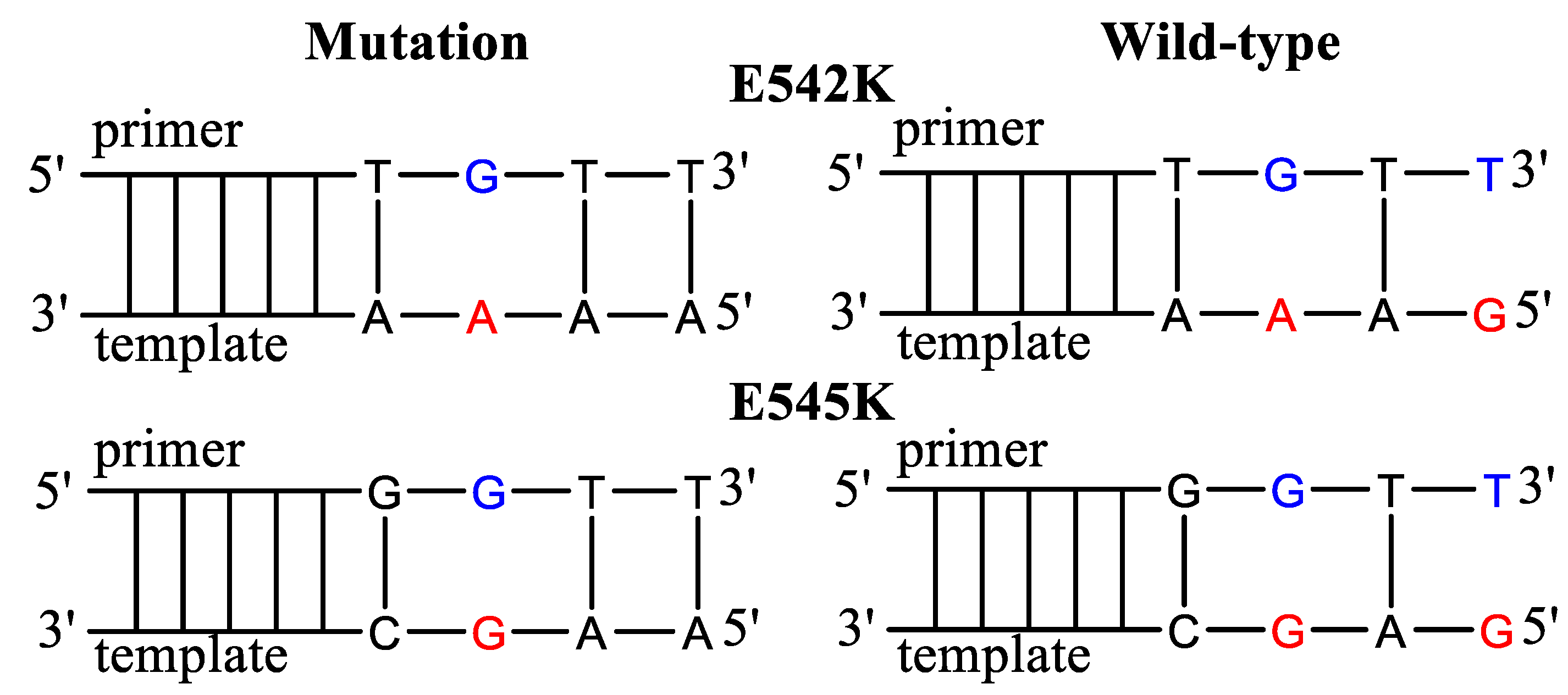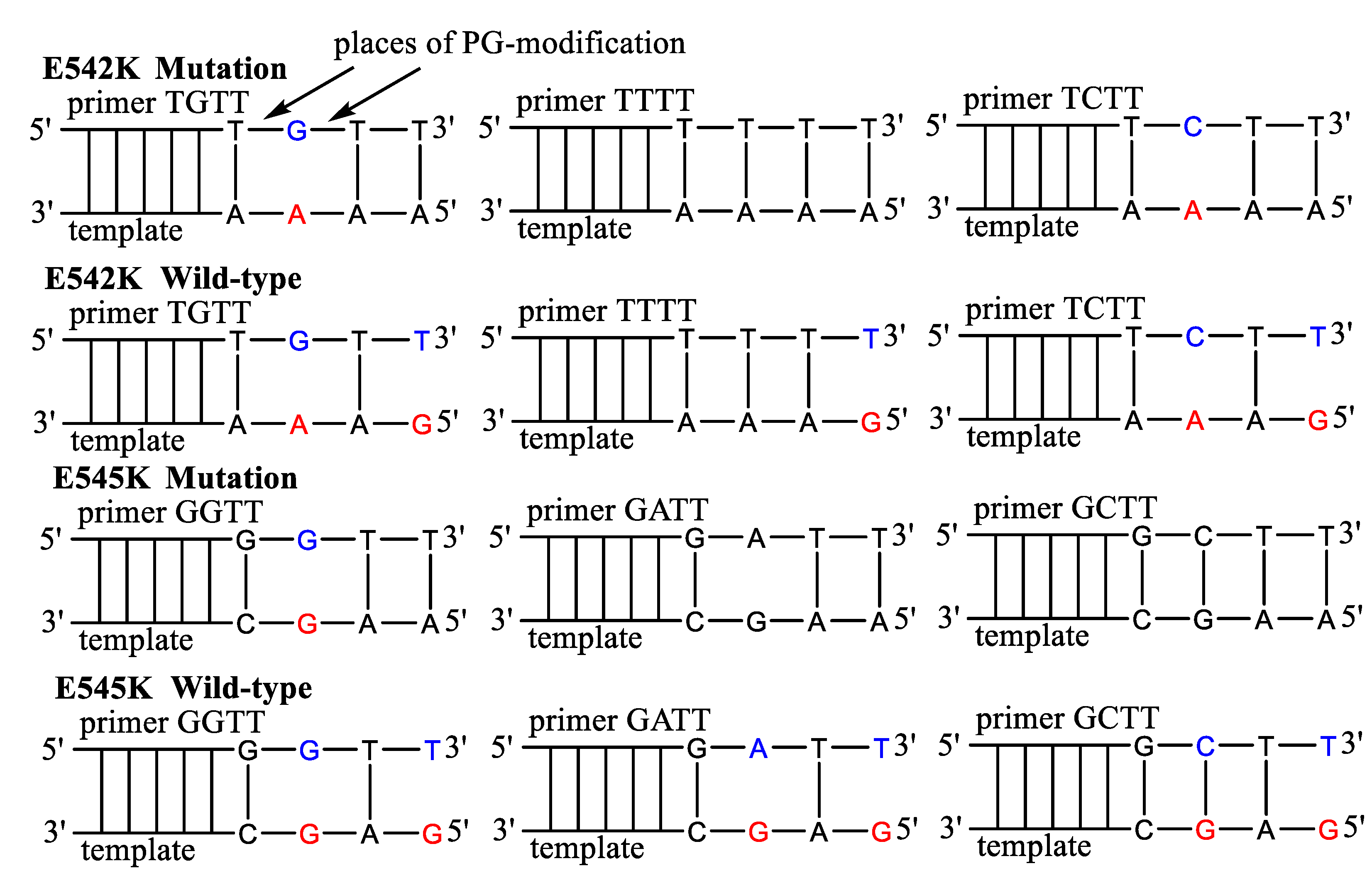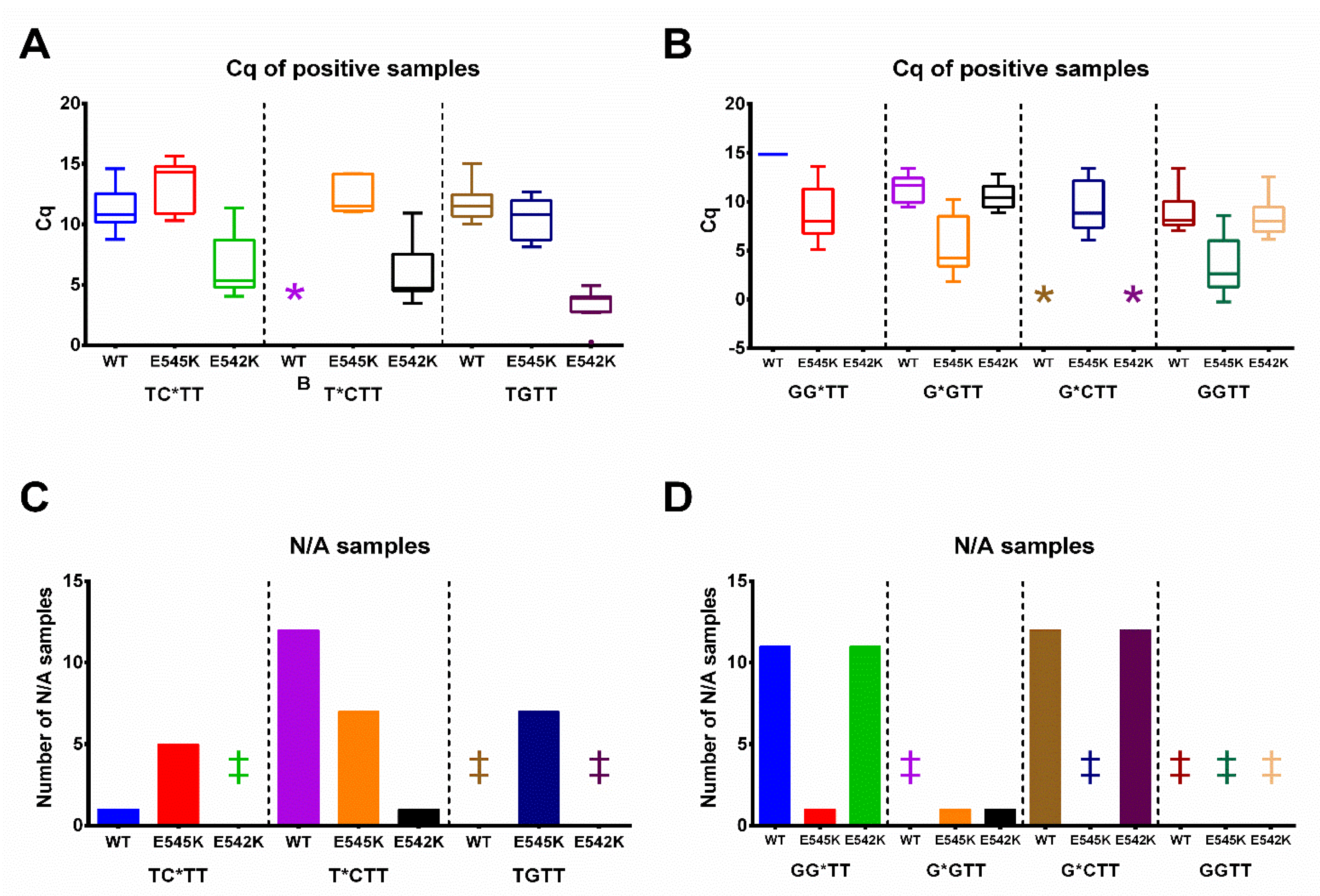Allele-Specific PCR for PIK3CA Mutation Detection Using Phosphoryl Guanidine Modified Primers
Abstract
1. Introduction
2. Materials and Methods
2.1. Synthesis and Isolation of Oligonucleotides
2.2. Plasmid Standards
2.3. qPCR
2.4. Clinical Samples and DNA Extraction
2.5. Droplet Digital PCR
3. Results
3.1. Design of Allele-Specific Primers with PG-Modification
3.2. PG-Modified Primers Specificity
3.3. Assay Performance on the Formalin-Fixed Paraffin-Embedded (FFPE) Tissues
4. Discussion
5. Conclusions
Supplementary Materials
Author Contributions
Funding
Institutional Review Board Statement
Informed Consent Statement
Data Availability Statement
Conflicts of Interest
References
- Voutsadakis, I.A. PI3KCA Mutations in Uterine Cervix Carcinoma. J. Clin. Med. 2021, 10, 220. [Google Scholar] [CrossRef] [PubMed]
- Criscitiello, C.; Marra, A.; Curigliano, G. PIK3CA Mutation Assessment in HR+/HER2− Metastatic Breast Cancer: Overview for Oncology Clinical Practice. J. Mol. Pathol. 2021, 2, 42–54. [Google Scholar] [CrossRef]
- Voutsadakis, I.A. The Landscape of PIK3CA Mutations in Colorectal Cancer. Clin. Color. Cancer 2021, 20, 201–215. [Google Scholar] [CrossRef] [PubMed]
- Alqahtani, A.; Ayesh, H.S.K.; Halawani, H. PIK3CA Gene Mutations in Solid Malignancies: Association with Clinicopathological Parameters and Prognosis. Cancers 2020, 12, 93. [Google Scholar] [CrossRef] [PubMed]
- Keraite, I.; Garcia, V.A.; Murillas, I.G.; Beaney, M.; Turner, N.C.; Bartos, C.; Oikonomidou, O.; Kerhoas, M.K.; Leslie, N.R. PIK3CA mutation enrichment and quantitation from blood and tissue. Sci. Rep. 2020, 10, 17082. [Google Scholar] [CrossRef]
- Jiang, W.; He, T.; Liu, S.; Zheng, Y.; Xiang, L.; Pei, X.; Wang, Z.; Yang, H. The PIK3CA E542K and E545K mutations promote glycolysis and proliferation via induction of the β-catenin/SIRT3 signaling pathway in cervical cancer. J. Hematol. Oncol. 2018, 11, 1–15. [Google Scholar] [CrossRef]
- Su, Y.F.; Tsai, E.M.; Chen, C.C.; Wu, C.C.; Er, T.K. Targeted sequencing of a specific gene panel detects a high frequency of ARID1A and PIK3CA mutations in ovarian clear cell carcinoma. Clin. Chim. Acta 2019, 494, 1–7. [Google Scholar] [CrossRef]
- Borkowska, E.M.; Baranska, M.; Kowalczyk, M.; Pietruszewska, W. Detection of PIK3CA Gene Mutation in Head and Neck Squamous Cell Carcinoma Using Droplet Digital PCR and RT-qPCR. Biomolecules 2021, 11, 818. [Google Scholar] [CrossRef] [PubMed]
- Jauhri, M.; Bhatnagar, A.; Gupta, S.; BP, M.; Minhas, S.; Shokeen, Y.; Aggarwal, S. Prevalence and coexistence of KRAS, BRAF, PIK3CA, NRAS, TP53, and APC mutations in Indian colorectal cancer patients: Next-generation sequencing–based cohort study. Tumor Biol. 2017, 39, 101042831769226. [Google Scholar] [CrossRef]
- Li, W.; Qiu, T.; Dong, L.; Zhang, F.; Guo, L.; Ying, J. Prevalence and characteristics of PIK3CA mutation in mismatch repair-deficient colorectal cancer. J. Cancer 2020, 11, 3827–3833. [Google Scholar] [CrossRef]
- Hsieh, L.L.; Er, T.K.; Chen, C.C.; Hsieh, J.S.; Chang, J.G.; Liu, T.C. Characteristics and prevalence of KRAS, BRAF, and PIK3CA mutations in colorectal cancer by high-resolution melting analysis in Taiwanese population. Clin. Chim. Acta 2012, 413, 1605–1611. [Google Scholar] [CrossRef] [PubMed]
- Board, R.E.; Thelwell, N.J.; Ravetto, P.F.; Little, S.; Ranson, M.; Dive, C.; Hughes, A.; Whitcombe, D. Multiplexed assays for detection of mutations in PIK3CA. Clin. Chem. 2008, 54, 757–760. [Google Scholar] [CrossRef] [PubMed]
- Patel, R.; Tsan, A.; Tam, R.; Desai, R.; Spoerke, J.; Schoenbrunner, N.; Myers, T.W.; Bauer, K.; Smith, E.; Raja, R. Mutation scanning using MUT-MAP, a high-throughput, microfluidic chip-based, multi-analyte panel. PLoS ONE 2012, 7, e51153. [Google Scholar] [CrossRef] [PubMed]
- Zeng, Q.; Xie, L.; Zhou, N.; Liu, M.; Song, X. Detection of PIK3CA Mutations in Plasma DNA of Colorectal Cancer Patients by an Ultra-Sensitive PNA-Mediated PCR. Mol. Diagn. Ther. 2017, 21, 443–451. [Google Scholar] [CrossRef]
- Cao, G.; Chen, X.; Deng, Y.; Nie, F.; Liu, Y.; Wang, G.; Huo, D.; Hou, C. Single-nucleotide variant of PIK3CA H1047R gene assay by CRISPR/Cas12a combined with rolling circle amplification. Anal. Chim. Acta 2021, 1182, 338943. [Google Scholar] [CrossRef]
- Filipenko, M.L.; Shamovskaya, D.V.; Oskina, N.A.; Oscorbin, I.P.; Khrapov, E.A.; Ovchinnikova, L.K.; Gershteyn, E.S.; Kushlinskii, N.E. Development of a multiplex allele-specific real-time PCR method for detection of PIK3CA gene somatic mutations and its validation in the tumors of breast cancer patients. Alm. Clin. Med. 2016, 41, 12–18. [Google Scholar] [CrossRef]
- Corné, J.; Le Du, F.; Quillien, V.; Godey, F.; Robert, L.; Bourien, H.; Brunot, A.; Crouzet, L.; Perrin, C. Development of multiplex digital PCR assays for the detection of PIK3CA mutations in the plasma of metastatic breast cancer patients. Sci. Rep. 2021, 11, 1–12. [Google Scholar] [CrossRef]
- Chung, T.K.H.; Doran, G.; Cheung, T.; Yim, S.; Yu, M.; Worley, M.J.; Elias, K.M.; Thorner, A.R.; Pedamallu, C.S.; Ojesina, A.I.; et al. Dissection of PIK3CA Aberration for Cervical Adenocarcinoma Outcomes. Cancers 2021, 13, 3218. [Google Scholar] [CrossRef]
- Desriani; Al-Ahwani, F. The sensitivity and efficacy method of PIK3CA exon 9 E545A as a high diagnostic accuracy in breast cancer. J. Genet. Eng. Biotechnol. 2018, 16, 71–76. [Google Scholar] [CrossRef]
- Shimoi, T.; Noguchi, E.; Hamada, A.; Yamagishi, M.; Hirai, M.; Sudo, K.; Shimomura, A.; Yonemori, K.; Shimizu, C.; Yoshida, M.; et al. PIK3CA mutation profiling in patients with breast cancer, using a highly sensitive detection system. Cancer Sci. 2018, 109, 2558–2566. [Google Scholar] [CrossRef]
- Alvarez-garcia, V.; Bartos, C.; Keraite, I.; Trivedi, U.; Brennan, P.M.; Kersaudy-kerhoas, M.; Gharbi, K.; Oikonomidou, O.; Leslie, N.R. A simple and robust real-time qPCR method for the detection of PIK3CA mutations. Sci. Rep. 2018, 8, 4290. [Google Scholar] [CrossRef] [PubMed]
- Vorkas, P.A.; Poumpouridou, N.; Agelaki, S.; Kroupis, C.; Georgoulias, V.; Lianidou, E.S. PIK3CA hotspot mutation scanning by a novel and highly sensitive high-resolution small amplicon melting analysis method. J. Mol. Diagn. 2010, 12, 697–704. [Google Scholar] [CrossRef] [PubMed]
- Schmidt, H.; Kulasinghe, A.; Allcock, R.J.N.; Tan, L.Y.; Mokany, E.; Kenny, L.; Punyadeera, C. A Pilot Study to Non-Invasively Track PIK3CA Mutation in Head and Neck Cancer. Diagnostics 2018, 8, 79. [Google Scholar] [CrossRef] [PubMed]
- Oscorbin, I.P.; Beginyazova, O.P.; Khlistun, I.V.; Shamovskaya, D.V.; Oskina, N.A.; Filipenko, M.L. Development of a multiplex allele-specific qPCR approach for testing PIK3CA mutations in patients with colorectal cancer. Heliyon 2022, 8, e11804. [Google Scholar] [CrossRef]
- Timar, J.; Kashofer, K. Molecular epidemiology and diagnostics of KRAS mutations in human cancer. Cancer Metastasis Rev. 2020, 39, 1029–1038. [Google Scholar] [CrossRef]
- Arastehfar, A.; Boekhout, T.; Butler, G.; Buda De Cesare, G.; Dolk, E.; Gabaldón, T.; Hafez, A.; Hube, B.; Hagen, F.; Hovhannisyan, H.; et al. Recent trends in molecular diagnostics of yeast infections: From PCR to NGS. FEMS Microbiol. Rev. 2019, 43, 517–547. [Google Scholar] [CrossRef]
- Van Dijk, E.L.; Jaszczyszyn, Y.; Naquin, D.; Thermes, C. The Third Revolution in Sequencing Technology. Trends Genet. 2018, 34, 666–681. [Google Scholar] [CrossRef]
- Ishak, A.; Alrawashdeh, M.M.; Esagian, S.M.; Nikas, I.P. Diagnostic, prognostic, and therapeutic value of droplet digital pcr (Ddpcr) in covid-19 patients: A systematic review. J. Clin. Med. 2021, 10, 5712. [Google Scholar] [CrossRef]
- Rejali, N.A.; Moric, E.; Wittwer, C.T. The effect of single mismatches on primer extension. Clin. Chem. 2018, 64, 801–809. [Google Scholar] [CrossRef]
- Liu, J.; Huang, S.; Sun, M.; Liu, S.; Liu, Y.; Wang, W.; Zhang, X.; Wang, H.; Hua, W. An improved allele-specific PCR primer design method for SNP marker analysis and its application. Plant Methods 2012, 8, 34. [Google Scholar] [CrossRef]
- Aggarwal, A.; Mehta, S.; Gupta, D.; Sheikh, S.; Pallagatti, S.; Singh, R.; Singla, I. Clinical & immunological erythematosus patients characteristics in systemic lupus Maryam. J. Dent. Educ. 2012, 76, 1532–1539. [Google Scholar] [CrossRef] [PubMed]
- Chang, Y.-H.; Wu, M.-W.; Chen, Y.-J.; Vu, C.-A.; Hong, C.-Y.; Chen, W.-Y. Phosphate-Methylated Oligonucleotides as a Novel Primer for PCR and RT-PCR. In PCR Primer Design; Humana: New York, NY, USA, 2022; Volume 2392, pp. 261–273. ISBN 9781071617984. [Google Scholar]
- Navarro, E.; Serrano-Heras, G.; Castaño, M.J.; Solera, J. Real-time PCR detection chemistry. Clin. Chim. Acta 2015, 439, 231–250. [Google Scholar] [CrossRef] [PubMed]
- Kuo, T.C.; Wu, M.W.; Lin, W.C.; Matulis, D.; Yang, Y.S.; Li, S.Y.; Chen, W.Y. Reduction of interstrand charge repulsion of DNA duplexes by salts and by neutral phosphotriesters—Contrary effects for harnessing duplex formation. J. Taiwan Inst. Chem. Eng. 2020, 110, 1–7. [Google Scholar] [CrossRef]
- Li, T.L.; Wu, M.W.; Lin, W.C.; Lai, C.H.; Chang, Y.H.; Su, L.J.; Chen, W.Y. Designed phosphate-methylated oligonucleotides as PCR primers for SNP discrimination. Anal. Bioanal. Chem. 2019, 411, 3871–3880. [Google Scholar] [CrossRef]
- Ishige, T.; Itoga, S.; Matsushita, K. Locked Nucleic Acid Technology for Highly Sensitive Detection of Somatic Mutations in Cancer, 1st ed.; Elsevier Inc.: Amsterdam, The Netherlands, 2018; Volume 83. [Google Scholar]
- Yang, H.L.; Jiang, H.J.; Fang, W.Y.; Xu, Y.Y.; Li, K.; Zhang, J.; Liao, D.F.; He, F.C. High fidelity PCR with an off/on switch mediated by proofreading polymerases combining with phosphorothioate-modified primer. Biochem. Biophys. Res. Commun. 2005, 328, 265–272. [Google Scholar] [CrossRef]
- D’Agata, R.; Giuffrida, M.C.; Spoto, G. Peptide Nucleic Acid-Based Biosensors for Cancer Diagnosis. Molecules 2017, 22, 1951. [Google Scholar] [CrossRef]
- Gupta, A.; Mishra, A.; Puri, N. Peptide nucleic acids: Advanced tools for biomedical applications. J. Biotechnol. J. 2017, 259, 148–159. [Google Scholar] [CrossRef]
- Saarbach, J.; Sabale, P.M.; Winssinger, N. Peptide nucleic acid (PNA) and its applications in chemical biology, diagnostics, and therapeutics. Curr. Opin. Chem. Biol. 2019, 52, 112–124. [Google Scholar] [CrossRef]
- Ballantyne, K.N.; van Oorschot, R.A.H.; Mitchell, R.J. Locked nucleic acids in PCR primers increase sensitivity and performance. Genomics 2008, 91, 301–305. [Google Scholar] [CrossRef]
- Ang, D.; Gara, R.O.; Schilling, A.; Beadling, C.; Warrick, A.; Troxell, M.L.; Corless, C.L. Novel Method for PIK3CA Mutation Analysis Locked Nucleic Acid e PCR Sequencing. J. Mol. Diagn. 2013, 15, 312–318. [Google Scholar] [CrossRef]
- Kupryushkin, M.S.; Pyshnyi, D.V.; Stetsenko, D.A. Phosphoryl guanidines: A new type of nucleic acid analogues. Acta Naturae 2014, 6, 116–118. [Google Scholar] [CrossRef]
- Stetsenko, D.A.; Kupryushkin, M.S.; Pyshnyi, D. Modified Oligonucleotides and Methods for Their Synthesis WO 2016/028187 Al Priority from 22 August 2014. Available online: https://patentscope.wipo.int/search/en/detail.jsf?docId=WO2016028187 (accessed on 27 September 2022).
- Chubarov, A.S.; Oscorbin, I.P.; Filipenko, M.L.; Lomzov, A.A.; Pyshnyi, D.V. Allele-specific PCR for KRAS mutation detection using phosphoryl guanidine modified primers. Diagnostics 2020, 10, 872. [Google Scholar] [CrossRef] [PubMed]
- Dyudeeva, E.S.; Kupryushkin, M.S.; Lomzov, A.A.; Pyshnaya, I.A.; Pyshnyi, D.V. Physicochemical Properties of the Phosphoryl Guanidine Oligodeoxyribonucleotide Analogs. Russ. J. Bioorg. Chem. 2019, 45, 709–718. [Google Scholar] [CrossRef]
- Golyshev, V.M.; Pyshnyi, D.V.; Lomzov, A.A. Effects of Phosphoryl Guanidine Modification of Phosphate Residues on the Structure and Hybridization of Oligodeoxyribonucleotides. J. Phys. Chem. B 2021, 125, 2841–2855. [Google Scholar] [CrossRef] [PubMed]
- Dmitriyenko, E.V.; Naumova, O.; Fomin, B.; Kupryushkin, M.S.; Volkova, A.; Amirkhanov, N.V.; Semenov, D.V.; Pyshnaya, I.A.; Pyshnyi, D.V. Surface modification of SOI-FET sensors for label-free and specific detection of short RNA analyte. Nanomedicine 2016, 11, 2073–2082. [Google Scholar] [CrossRef]
- Garafutdinov, R.R.; Sakhabutdinova, A.R.; Kupryushkin, M.S.; Pyshnyi, D.V. Prevention of DNA multimerization using phosphoryl guanidine primers during isothermal amplification with Bst exo- DNA polymerase. Biochimie 2020, 168, 259–267. [Google Scholar] [CrossRef]
- Epanchintseva, A.; Dolodoev, A.; Grigoryeva, A.; Chelobanov, B.; Pyshnyi, D.; Ryabchikova, E.; Pyshnaya, I. Non-covalent binding of nucleic acids with gold nanoparticles provides their stability and effective desorption in environment mimicking biological media. Nanotechnology 2018, 29, 355601. [Google Scholar] [CrossRef]
- Kuznetsov, N.A.; Kupryushkin, M.S.; Abramova, T.V.; Kuznetsova, A.A.; Miroshnikova, A.D.; Stetsenko, D.A.; Pyshnyi, D.V.; Fedorova, O.S. New oligonucleotide derivatives as unreactive substrate analogues and potential inhibitors of human apurinic/apyrimidinic endonuclease APE1. Mol. Biosyst. 2015, 12, 67–75. [Google Scholar] [CrossRef]
- Lebedeva, N.A.; Anarbaev, R.O.; Kupryushkin, M.S.; Rechkunova, N.I.; Pyshnyi, D.V.; Stetsenko, D.A.; Lavrik, O.I. Design of a New Fluorescent Oligonucleotide-Based Assay for a Highly Specific Real-Time Detection of Apurinic/Apyrimidinic Site Cleavage by Tyrosyl-DNA Phosphodiesterase 1. Bioconjug. Chem. 2015, 26, 2046–2053. [Google Scholar] [CrossRef]
- Kupryushkin, M.S.; Pyshnaya, I.A.; Dmitrienko, E.V.; Stetsenko, D.A.; Filipenko, M.L.; Oscorbin, I.P.; Stepanov, G.A.; Richter, V.A.; Ivanov, M.K.; Pyshnyi, D.V. Template-directed Enzymatic DNA Synthesis Using Phosphoryl Guanidine Oligonucleotides WO 2019/112485 A1 Priority from 4 December 2017. Available online: https://patentscope.wipo.int/search/en/detail.jsf?docId=WO2019112485 (accessed on 27 September 2022).
- Lomzov, A.A.; Kupryushkin, M.S.; Shernyukov, A.V.; Nekrasov, M.D.; Dovydenko, I.S.; Stetsenko, D.A.; Pyshnyi, D.V. Diastereomers of a mono-substituted phosphoryl guanidine trideoxyribonucleotide: Isolation and properties. Biochem. Biophys. Res. Commun. 2019, 513, 807–811. [Google Scholar] [CrossRef]
- Vinogradova, O.A.; Pyshnyi, D.V. Selectivity of Enzymatic Conversion of Oligonucleotide Probes during Nucleotide Polymorphism Analysis of DNA. Acta Naturae 2010, 2, 36–52. [Google Scholar] [CrossRef] [PubMed]
- Tougeron, D.; Lecomte, T.; Pagès, J.C.; Villalva, C.; Collin, C.; Ferru, A.; Tourani, J.M.; Silvain, C.; Levillain, P.; Karayan-tapon, L. Effect of low-frequency KRAS mutations on the response to anti-EGFR therapy in metastatic colorectal cancer. Ann. Oncol. 2013, 24, 1267–1273. [Google Scholar] [CrossRef] [PubMed]




| Mutation | Reverse Primers/Template Fragment | Abbreviation |
|---|---|---|
| E542K Nucleotide (c.1624G>A) Amino Acid (p.E542K) COSMIC ID (COSV55873227) | 5′-AAATCTTTCTCCTGCTCAGTGATGTT-3′ | TGTT |
| WT DNA 5′-AAATCTTTCTCCTGCTCAGTGATTTC-3′ | - | |
| Mutant DNA 5′-AAATCTTTCTCCTGCTCAGTGATTTT-3′ | - | |
| E545K Nucleotide (c.1633G>A) Amino Acid (p.E545K) COSMIC ID (COSV55873239) | 5′-GACTCCATAGAAAATCTTTCTCCTGGTT-3′ | GGTT |
| WT DNA 5′-GACTCCATAGAAAATCTTTCTCCTGCTC-3′ | - | |
| Mutant DNA 5′-GACTCCATAGAAAATCTTTCTCCTGCTT-3′ | - |
| Mutation/Method | Reverse Primers | Abbreviation |
|---|---|---|
| E542K/qPCR | 5′-AAATCTTTCTCCTGCTCAGTGATGTT-3′ | TGTT |
| 5′-AAATCTTTCTCCTGCTCAGTGATG*TT-3′ | TG*TT | |
| 5′-AAATCTTTCTCCTGCTCAGTGAT*GTT-3′ | T*GTT | |
| 5′-AAATCTTTCTCCTGCTCAGTGATT*TT-3′ | TT*TT | |
| 5′-AAATCTTTCTCCTGCTCAGTGAT*TTT-3′ | T*TTT | |
| 5′-AAATCTTTCTCCTGCTCAGTGATC*TT-3′ | TC*TT | |
| 5′-AAATCTTTCTCCTGCTCAGTGAT*CTT-3′ | T*CTT | |
| E545K/qPCR | 5′-GACTCCATAGAAAATCTTTCTCCTGGTT-3′ | GGTT |
| 5′-GACTCCATAGAAAATCTTTCTCCTGG*TT-3′ | GG*TT | |
| 5′-GACTCCATAGAAAATCTTTCTCCTG*GTT-3′ | G*GTT | |
| 5′-GACTCCATAGAAAATCTTTCTCCTGA*TT-3′ | GA*TT | |
| 5′-GACTCCATAGAAAATCTTTCTCCTG*ATT-3′ | G*ATT | |
| 5′-GACTCCATAGAAAATCTTTCTCCTGC*TT-3′ | GC*TT | |
| 5′-GACTCCATAGAAAATCTTTCTCCTG*CTT-3′ | G*CTT | |
| ddPCR | 5′-AAGAACAGCTCAAAGCAATTTCTA-3′ | PIK-1 |
| 5′-TTTAGCACTTACCTGTGACTCCA-3′ | PIK-2 | |
| 5′-FAM-CGAGATCCTCTCTCTGAAATCAC-BHQ2-3′ | PIK-WT1 | |
| 5′-HEX-CGAGATCCTCTCTCTAAAATCAC-BHQ2-3′ | PIK-E542K | |
| 5′-FAM-AGAAAATCTTTCTCCTGCTCAGT-BHQ2-3′ | PIK-WT2 | |
| 5′-HEX-AGAAAATCTTTCTCCTGCTTAGT-BHQ2-3′ | PIK-E545K |
| Primers | Cq | ΔCq | PCR Efficiency, % | ||
|---|---|---|---|---|---|
| WT | 1% | CqWT − Cq1% | |||
| E542K | TGTT | 34.5 ± 0.5 | 33.5 ± 0.1 | 1.0 | 101.4 |
| TG*TT | N/A | N/A | - | n.d. | |
| T*GTT | 37.8 ± 0.2 | 36.1 ± 0.4 | 1.7 | 67.0 | |
| TC*TT | 39.6 ± 0.4 | 37.3 ± 0.1 | 2.3 | 85.4 | |
| T*CTT | 37.8 ± 0.3 | 35.8 ± 0.2 | 2.0 | 86.3 | |
| TT*TT | 35.6 ± 0.3 | 35.5 ± 0.3 | 0.1 | n.d. | |
| T*TTT | 35.8 ± 0.1 | 34.7 ± 0.2 | 1.1 | 75.0 | |
| E545K | GGTT | 31.6 ± 0.1 | 31.2 ± 0.1 | 0.4 | 107.2 |
| GG*TT | 42.9 ± 0.4 | 39.0 ± 0.4 | 3.9 | 87.6 | |
| G*GTT | 39.4 ± 0.5 | 36.9 ± 0.1 | 2.5 | 83.6 | |
| GA*TT | 38.1 ± 0.1 | 36.5 ± 0.2 | 1.6 | 74.7 | |
| G*ATT | 42.1 ± 0.3 | 39.3 ± 0.2 | 2.8 | 78.6 | |
| GC*TT | 35.3 ± 0.1 | 35.1 ± 0.1 | 0.2 | n.d. | |
| G*CTT | 42.2 ± 0.4 | 39.6 ± 0.3 | 2.6 | 88.1 | |
| Primers | Cq | ΔCq = CqWT − Cq% | ||||
|---|---|---|---|---|---|---|
| WT | 0.5% | 1% | WT–0.5% | WT–1% | ||
| E542K | TGTT | 33.9 ± 0.5 | 33.2 ± 0.3 | 32.8 ± 0.2 | 0.7 | 1.1 |
| T*GTT | 37.3 ± 0.5 | 36.2 ± 0.2 | 35.4 ± 0.3 | 1.1 | 1.9 | |
| TC*TT | 39.5 ± 0.6 | 37.4 ± 0.1 | 36.9 ± 0.1 | 2.1 | 2.6 | |
| T*CTT | 38.0 ± 0.7 | 36.2 ± 0.4 | 36.0 ± 0.2 | 1.8 | 2.0 | |
| T*TTT | 35.7 ± 0.3 | 34.7 ± 0.2 | 34.7 ± 0.4 | 1.0 | 1.0 | |
| E545K | GGTT | 30.9 ± 0.1 | 30.7 ± 0.1 | 30.6 ± 0.1 | 0.2 | 0.3 |
| GG*TT | 41.4 ± 0.6 | 39.5 ± 0.3 | 38.4 ± 0.1 | 1.9 | 3.0 | |
| G*GTT | 38.9 ± 0.6 | 36.5 ± 0.1 | 35.9 ± 0.1 | 2.4 | 3.0 | |
| GA*TT | 37.6 ± 0.7 | 36.2 ± 0.1 | 35.8 ± 0.2 | 1.4 | 1.8 | |
| G*ATT | 41.2 ± 0.6 | 39.4 ± 0.4 | 38.7 ± 0.2 | 1.8 | 2.5 | |
| G*CTT | 42.5 ± 0.7 | 39.5 ± 0.1 | 38.5 ± 0.1 | 3.0 | 4.0 | |
| Primer/Mutation | ΔCq Cut-Off | Sensitivity 1 | Specificity 2 |
|---|---|---|---|
| GGTT E545K | 2.84 | 56%/83% 3 | 100% |
| GG*TT E545K | 10.55 | 67%/100% | 100% |
| G*GTT E545K | 8.00 | 78%/100% | 100% |
| G*CTT E545K | 10.64 | 67%/100% | 100% |
| TGTT E542K | 4.31 | 86%/100% | 100% |
| TC*TT E542K | 7.67 | 86%/100% | 100% |
| T*CTT E542K | 7.84 | 86%/100% | 100% |
Disclaimer/Publisher’s Note: The statements, opinions and data contained in all publications are solely those of the individual author(s) and contributor(s) and not of MDPI and/or the editor(s). MDPI and/or the editor(s) disclaim responsibility for any injury to people or property resulting from any ideas, methods, instructions or products referred to in the content. |
© 2023 by the authors. Licensee MDPI, Basel, Switzerland. This article is an open access article distributed under the terms and conditions of the Creative Commons Attribution (CC BY) license (https://creativecommons.org/licenses/by/4.0/).
Share and Cite
Chubarov, A.S.; Oscorbin, I.P.; Novikova, L.M.; Filipenko, M.L.; Lomzov, A.A.; Pyshnyi, D.V. Allele-Specific PCR for PIK3CA Mutation Detection Using Phosphoryl Guanidine Modified Primers. Diagnostics 2023, 13, 250. https://doi.org/10.3390/diagnostics13020250
Chubarov AS, Oscorbin IP, Novikova LM, Filipenko ML, Lomzov AA, Pyshnyi DV. Allele-Specific PCR for PIK3CA Mutation Detection Using Phosphoryl Guanidine Modified Primers. Diagnostics. 2023; 13(2):250. https://doi.org/10.3390/diagnostics13020250
Chicago/Turabian StyleChubarov, Alexey S., Igor P. Oscorbin, Lidiya M. Novikova, Maxim L. Filipenko, Alexander A. Lomzov, and Dmitrii V. Pyshnyi. 2023. "Allele-Specific PCR for PIK3CA Mutation Detection Using Phosphoryl Guanidine Modified Primers" Diagnostics 13, no. 2: 250. https://doi.org/10.3390/diagnostics13020250
APA StyleChubarov, A. S., Oscorbin, I. P., Novikova, L. M., Filipenko, M. L., Lomzov, A. A., & Pyshnyi, D. V. (2023). Allele-Specific PCR for PIK3CA Mutation Detection Using Phosphoryl Guanidine Modified Primers. Diagnostics, 13(2), 250. https://doi.org/10.3390/diagnostics13020250








